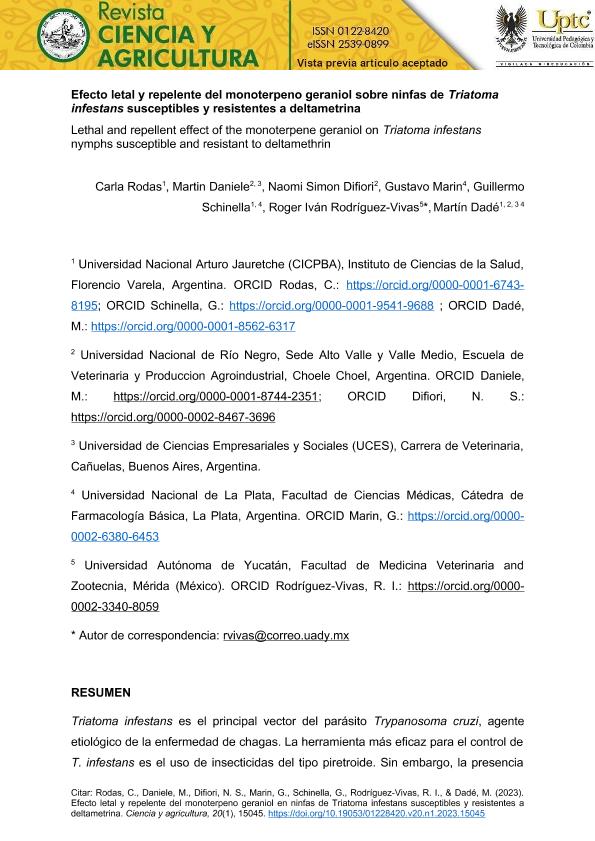Artículo
Triatoma infestans es el principal vector del parásito Trypanosoma cruzi, agente etiológico de la enfermedad de chagas. La herramienta más eficaz para el control de T. infestans es el uso de insecticidas del tipo piretroide. Sin embargo, la presencia de ejemplares de T. infestans resistentes a los piretroides conlleva a la necesidad de buscar nuevas alternativas para su control. Los bioinsecticidas se posicionan en la actualidad como una alternativa novedosa, menos agresiva para el ambiente y de menor costo con respecto al uso de los insecticidas sintéticos tradicionales. El geraniol es un monoterpeno que ha demostrado tener actividad insecticida y repelente en insectos. Los objetivos del presente trabajo fueron determinar y comparar la actividad letal y repelente del geraniol solo y en combinación con el insecticida piretroide deltametrina y el repelente de insectos N,N-Dietil-metatoluamida (DEET). Se demostró que el geraniol tiene una actividad letal similar en ninfas susceptibles y resistentes a piretroides (grado de resistencia de 0,8). Cuando se combinaron los dos insecticidas, el geraniol mostró un efecto sinérgico sobre la letalidad de la deltametrina. En cuanto a la actividad repelente, a bajas concentraciones, el geraniol fue menos potente que el DEET; sin embargo, cuando se combinaron ambas moléculas, la presencia de este monoterpeno aumentó la capacidad de repelencia del DEET al 100%. Se concluye que el geraniol tiene actividad letal sobre ninfas de T. infestans susceptibles y resistentes a los piretroides y tiene un efecto sinérgico sobre la letalidad de la deltametrina. Asimismo, el geraniol aumentó la capacidad de repelencia del DEET sobre T. infestans. Triatoma infestans is the main vector of the Trypanosoma cruzi parasite, the etiological agent of Chagas disease. Pyrethroid insecticides are the most effective strategy for controlling T. infestans. However, the presence of specimens of T. infestans resistant to pyrethroids now raises the need to seek new alternatives for their control. Bioinsecticides are currently positioned as a novel alternative, less aggressive for the environment and less costly compared to traditional synthetic insecticides. Geraniol is a monoterpene that has been shown to have insecticidal and repellent activity on insects. The objectives of this work were to determine and compare the lethal and repellent activity of geraniol alone and in combination with the pyrethroid insecticide deltamethrin and the insect repellent N,N-Diethyl-meta-toluamide (DEET). Geraniol has been shown to be similar lethal to pyrethroid-susceptible and -resistant nymphs (resistance ratio of 0.8). When the two insecticides were combined, geraniol showed a synergistic effect on the lethality of deltamethrin. In terms of repellent activity, geraniol was less effective than DEET at low concentrations; however, when both molecules were combined, the presence of this monoterpene increased the repellency capacity of DEET to 100%. It is concluded that geraniol has lethal activity on T. infestans nymphs susceptible and resistant to pyrethroids and has a synergistic effect on the lethality of deltamethrin. Likewise, geraniol increased the repellency capacity of DEET on T. infestans.
Efecto letal y repelente del monoterpeno geraniol sobre ninfas de Triatoma infestans susceptibles y resistentes a deltametrina
Título:
Lethal and repellent effect of the monoterpene geraniol on Triatoma infestans nymphs susceptible and resistant to deltamethrin
Rodas, Carla; Daniele, Martin Rafael; Simón Difiori, Naomi; Marin, Gustavo Horacio ; Schinella, Guillermo Raúl; Dadé, Martin Miguel
; Schinella, Guillermo Raúl; Dadé, Martin Miguel
 ; Schinella, Guillermo Raúl; Dadé, Martin Miguel
; Schinella, Guillermo Raúl; Dadé, Martin Miguel
Fecha de publicación:
10/2023
Editorial:
Universidad Pedagógica y Tecnológica
Revista:
Ciencia y Agricultura
ISSN:
0122-8420
e-ISSN:
2539-0899
Idioma:
Español
Tipo de recurso:
Artículo publicado
Clasificación temática:
Resumen
Palabras clave:
TRIATOMA
,
CHAGAS
,
VINCHUCA
Archivos asociados
Licencia
Identificadores
Colecciones
Articulos(CCT - LA PLATA)
Articulos de CTRO.CIENTIFICO TECNOL.CONICET - LA PLATA
Articulos de CTRO.CIENTIFICO TECNOL.CONICET - LA PLATA
Citación
Rodas, Carla; Daniele, Martin Rafael; Simón Difiori, Naomi; Marin, Gustavo Horacio; Schinella, Guillermo Raúl; et al.; Efecto letal y repelente del monoterpeno geraniol sobre ninfas de Triatoma infestans susceptibles y resistentes a deltametrina; Universidad Pedagógica y Tecnológica; Ciencia y Agricultura; 20; 1; 10-2023; 15045-15058
Compartir
Altmétricas



